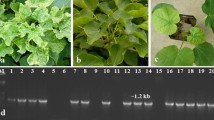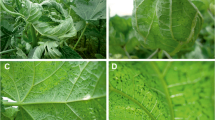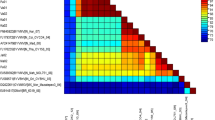Abstract
A begomovirus isolate (OY136A) collected from okra plants showing upward leaf curling, vein clearing, vein thickening and yellowing symptoms from Bangalore rural district, Karnataka, India was characterized. The sequence comparisons revealed that, this virus isolate share highest nucleotide identity with isolates of Cotton leaf curl Bangalore virus (CLCuBV) (AY705380) (92.8 %) and Okra enation leaf curl virus (81.1–86.2 %). This is well supported by phylogentic analysis showing, close clustering of the virus isolate with CLCuBV. With this data, based on the current taxonomic criteria for the genus Begomovirus, the present virus isolate is classified as a new strain of CLCuBV, for which CLCuBV-[India: Bangalore: okra: 2006] additional descriptor is proposed. The betasatellite (KC608158) associated with the virus is having more than 95 % sequence similarity with the cotton leaf curl betasatellites (CLCuB) available in the GenBank.The recombination analysis suggested, emergence of this new strain of okra infecting begomovirus might have been from the exchange of genetic material between BYVMV and CLCuMuV. The virus was successfully transmitted by whitefly and grafting. The host range of the virus was shown to be very narrow and limited to two species in the family Malvaceae, okra (Abelmoschus esculentus) and hollyhock (Althaea rosea), and four in the family Solanaceae.




Similar content being viewed by others
References
Albuquerque LC, Martin DP, Avila AC, Inoue-Nagata AK. Characterization of tomato yellow vein streak virus, a begomovirus from Brazil. Virus Genes. 2010;40:140–7.
Briddon RW, Markham PG. Cotton leaf curl virus disease. Virus Res. 2000;71:151–9.
Briddon RW, Stanley J. Subviral agents associated with plant single-stranded DNA viruses. Virology. 2006;344:198–210.
Briddon RW, Bull SE, Amin I, Idris AM, Mansoor S, Bedford ID, Dhawan P, Rishi N, Siwatch SS, Abdel-Salam AM, Brown JK, Zafar Y, Markham PG. Diversity of DNA beta: a satellite molecule associated with some monopartite begomoviruses. Virology. 2003;312:106–21.
Briddon RW, Bull SE, Amin I, Mansoor S, Bedford ID, Rishi N, Siwatch SS, Zafar MY, Abdel-Salam AM, Markham PG. Diversity of DNA 1; a satellite-like molecule associated with monopartite begomovirus-DNA β complexes. Virology. 2004;324:462–74.
Briddon RW, Bull SE, Mansoor S, Amin I, Markham PG. Universal primers for the PCR-mediated amplification of DNA-β: a molecule associated with some monopartite begomoviruses. Mol Biotech. 2002;20:315–8.
Briddon RW, Mansoor S, Bedford ID, Pinner MS, Saunders K, Stanley J, Zafar Y, Malik KA, Markham PG. Identification of DNA components required for induction of cotton leaf curl disease. Virology. 2001;285:234–43.
Briddon RW, Pinner MS, Stanley J, Markham PG. Geminivirus coat protein gene replacement alters insect specificity. Virology. 1990;177:85–94.
Brown JK. The status of Bemisia tabaci (Genn.) as a pest and vector in world agroecosystems. FAO Plant Prot Bull. 1994;42:3–32.
Brown JK, Nelson MR. Host range and vector relationships of cotton leaf crumple virus. Plant Dis. 1987;71:522–4.
Brown JK, Bird J, Frohlich DR, Russell RC, Bedford ID, Markham PG. The relevance of variability within the Bemisia tabaci species complex to epidemics caused by sub-group–III geminiviruses. In: Gerling D, Mayer RT, editors. Bemisia 1995, Taxonomy, Biology, Damage, Control and Management 77–89. Andover: Intercept Ltd; 1995. pp. 702.
Bull SE, Briddon RW, Sserubombwe WS, Ngugi K, Markham PG, Stanley J. Genetic diversity and phylogeography of cassava mosaic viruses in Kenya. J Gen Virol. 2006;87:3053–65.
Bull SE, Tsai WS, Briddon RW, Markham PG, Stanley J, Green SK. Diversity of begomovirus DNA β satellites of non-malvaceous plants in east and south east Asia. Arch Virol. 2004;149:1193–200.
Capoor SP, Varma PM. Yellow vein mosaic of H.esculentus L. Indian J Agric Sci. 1950;20:217–30.
Chowda Reddy RV, Muniyappa V, Colvin J, Seal S. A new begomovirus isolated from Gossypium barbadense in southern India. Plant Pathol. 2005;54:570.
De La Torre-Almaraz R, Monsalvo-Reyes A, Romero-Rodriguez A, Argüello-Astorga GR, Ambriz-Granados S. A new begomovirus inducing yellow mottle in okra crops in Mexico is related to Sida yellow vein virus. Plant Dis. 2006;90:378.
Doyle JJ, Doyle JL. Isolation of plant DNA from fresh tissue. Focus. 1990;12:13–5.
Duffy S, Holmes EC. Phylogenetic evidence for rapid rates of molecular evolution in the single-stranded DNA begomovirus tomato yellow leaf curl virus. J Virol. 2008;82:957–65.
Fauquet CM, Briddon RW, Brown JK, Moriones E, Stanley J, Zerbini M, Zhou X. Geminivirus strain demarcation and nomenclature. Arch Virol. 2008;153:783–821.
Gilbertson R, Rojas M, Russell D, Maxwell D. Use of the asymmetric polymerase chain reaction and DNA sequencing to determine genetic variability of bean golden mosaic geminivirus in the Dominican Republic. J Gen Virol. 1991;72:2843–8.
Hall TA. BioEdit: a user-friendly biological sequence alignment editor and analysis program for Windows 95/98/NT. Nucleic Acids Symp Ser. 1999;41:95–8.
Hanley-Bowdoin L, Settleage SB, Orozco BM, Nagar S, Robertson D. Geminivirus:models for plant DNA replication, transcription, and cell cycle regulation. Crit Rev Plant Sci. 1999;18:71–106.
Harrison BD, Robinson DJ. Natural genomic and antigenic variation in whitefly-transmitted geminivirus (Begomoviruses). Annu Rev Phytopathol. 1999;37:369–98.
Hernandez-Zepeda C, Idris AM, Carnevali G, Brown JK, Moreno-Valenzuela OA. Molecular characterization and phylogenetic relationships of two new bipartite begomovirus infecting plants in Yucatan, Mexico. Virus Genes. 2007;35:369–77.
Heyraud F, Matzeit V, Kammann M, Schafer S, Schell J, Gronenborn B. Identification of the initiation sequence for viral-strand DNA synthesis of wheat dwarf virus. EMBO J. 1993;12:4445–52.
Huson DH, Bryant D. Application of phylogenetic networks in evolutionary studies. Mol Biol Evol. 2006;23:254–67.
Jose J, Usha R. Bhendi yellow vein mosaic disease in India is caused by association of a DNA β satellite with a begomovirus. Virology. 2003;305:310–7.
Kirthi N, Priyadarshini CGP, Sharma P, Maiya SP, Hemalatha V, Sivaraman P, Dhawan P, Rishi N, Savithri HS. Genetic variability of begomoviruses associated with cotton leaf curl disease originating from India. Arch Virol. 2004;149:2047–57.
Lazarowitz SG. Geminiviruses:genome structure and gene function. Crit Rev Plant Sci. 1992;11:327–49.
Lefeuvre P, Martin DP, Harkins G, Lemey P, Gray AJA, Meredith S, Lakay F, Monjane A, Lett J-M, Varsani A, Heydarnejad J. The spread of Tomato yellow leaf curl virus from the Middle East to the world. PLoS Pathog. 2010;6:e1001164.
Mansoor S, Amin I, Iram S, Hussain M, Zafar Y, Malik KA, Briddon RW. Breakdown of resistance in cotton to cotton leaf curl disease in Pakistan. Plant Pathol. 2003;52:784.
Mansoor S, Briddon RW, Bull SE, Bedford ID, Bashir A, Hussain M, Saeed M, Zafar MY, Malik KA, Fauquet CM, Markham PG. Cotton leaf curl disease is associated with multiple monopartite begomoviruses supported by single DNAβ. Arch Virol. 2003;148:1969–86.
Martin DP, Lemey P, Lott M, Vincent M, Posada D, Lefeuvre P. RDP3: a flexible and fast computer program for analyzing recombination. Bioinformatics. 2010;26(19):2462–3.
Morales FJ, Anderson PK. The emergence and dissemination of whitefly-transmitted geminiviruses in Latin America. Arch Virol. 2001;146:415–41.
Navot N, Pichersky E, Zeidan M, Zamir D, Czosnek H. Tomato yellow leaf curl virus: a whitefly-transmitted geminivirus with a single genomic component. Virology. 1991;185:151–61.
Nawaz-ul-Rehman MS, Nahid N, Mansoor S, Briddon RW, Fauquet CM. Post-transcriptional gene silencing suppressor activity of the alpha-Rep of non-pathogenic alphasatellites associated with begomoviruses. Virology. 2010;405:300–8.
Padidam M, Beachy RN, Fauquet CM. Tomato leaf curl geminivirus from India has a bipartite genome and coat protein is not essential for infectivity. J Gen Virol. 1995;76:25–35.
Padidam M, Sawyer S, Fauquet CM. Possible emergence of new geminiviruses by frequent recombination. Virology. 1999;265:218–25.
Paprotka T, Metzler V, Jeske H. The complete nucleotide sequence of a new bipartite begomovirus from Brazil infecting Abutilon. Arch Virol. 2010;155:813–6.
Pita JS, Fondong VN, Sangare A, Otim-Nape GW, Ogwal S, Fauquet CM. Recombination, pseudorecombination and synergism of geminivirus are determinant keys to the epidemic of severe cassava mosaic disease in Uganda. J Gen Virol. 2001;82:655–65.
Raychaudhuri SP, Nariani TK. Viruses and Mycoplasma diseases of plants in India. New Delhi: Oxford and IBH Publishing company; 1977. p. 160–7.
Retuerma ML, Pableo GO, Price WC. Preliminary study of the transmission of Philippines tomato leaf curls virus Bemisia tabaci Philippines. Phytopathology. 1971;7:29–34.
Rojas MR, Gilbertson RL, Russel DR, Maxwell DP. Use of degenerate primers in the polymerase chain reaction to detect whitefly-transmitted geminiviruses. Plant Dis. 1993;77:340–7.
Rojas MR, Hagen C, Lucas WJ, Gilbertson RL. Exploiting chinks in the plant’s armor: evolution and emergence of geminiviruses. Annu Rev Phytopathol. 2005;43:361–94.
Sanz AI, Fraile A, Gallego JM, Malpica JM, Garcia-Arenal F. Genetic variability of natural populations of cotton leaf curl geminivirus, a single-stranded DNA virus. J Mol Evol. 1999;49:672–81.
Sanz AI, Fraile A, Garcia Arenal F, Zhou XP, Robinson DJ, Khalid S, Butt T, Harrison BD. Multiple infection, recombination and genome relationships among begomovirus isolates found in cotton and other plants in Pakistan. J Gen Virol. 2000;81:1839–49.
Sastry KSM, Singh SJ. Effect of yellow vein mosaic virus infection on growth and yield of okra crop. Indian Phytopathol. 1974;27:294–7.
Saunders K, Bedford ID, Stanley J. Pathogenicity of a natural recombinant associated with ageratum yellow vein disease: implications for geminivirus evolution and disease aetiology. Virology. 2001;282:8–47.
Seal SE, Vandenbosch F, Jeger MJ. Factors influencing begomovirus evolution and their increasing global significance: implications for sustainable control. Crit Rev Plant Sci. 2006;25:23–46.
Sinha SN, Chakrabarthi AK. Effect of yellow vein mosaic virus infection on okra seed production. Seed Res. 1978;6:67–70.
Stanley J. Infectivity of the cloned geminivirus genome requires sequences from both DNAs. Nature. 1983;305:643–5.
Stanley J, Bisaro DM, Briddon RW, Brown JK, Fauquet CM, Harrison BD, Rybicki EP, Stenger DC. Geminiviridae. In: Fauquet CM, Mayo MA, Maniloff J, Desselberger U, Ball LA, editors. Virus taxonomy, VIIIth report of the ICTV. London: Elsevier/Academic Press; 2005. p. 301–26.
Tamura K, Peterson D, Peterson N, Stecher G, Nei M, Kumar S. MEGA5: Molecular evolutionary genetics analysis using maximum likelihood, evolutionary distance, and maximum parsimony methods. Mol Biol Evol. 2011;28(10):2731–9. doi:10.1093/molbev/msr.
Varma PM. Studies on the relationship of the bhendi yellow vein mosaic virus and vector, the whitefly (Bemisia tabaci). Indian J Agric Sci. 1952;22:75–91.
Varma A, Malathi VG. Emerging geminivirus problems: a serious threat to crop production. Annu App Biol. 2003;142:145–64.
Venkataravanappa V, Reddy CNL, Jalali S, Krishna Reddy M. Molecular characterization of distinct bipartite begomovirus infecting bhendi (Abelmoschus esculentus L.) in India. Virus Genes. 2012;44:522–35.
Wang XY, Xie Y, Zhou XP. Molecular characterization of two distinct begomoviruses in China. Virus Genes. 2004;29:303–9.
Acknowledgments
The research was supported by ICAR NETWORK Project on development of diagnostics to emerging plant viruses, Indian Council of Agricultural Research, Government of India, New Delhi.
Author information
Authors and Affiliations
Corresponding authors
Electronic supplementary material
Below is the link to the electronic supplementary material.
Rights and permissions
About this article
Cite this article
Venkataravanappa, V., Lakshminarayana Reddy, C.N., Devaraju, A. et al. Association of a recombinant Cotton leaf curl Bangalore virus with yellow vein and leaf curl disease of okra in India. Indian J. Virol. 24, 188–198 (2013). https://doi.org/10.1007/s13337-013-0141-4
Received:
Accepted:
Published:
Issue Date:
DOI: https://doi.org/10.1007/s13337-013-0141-4




